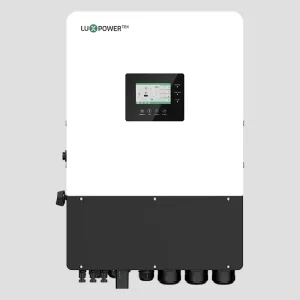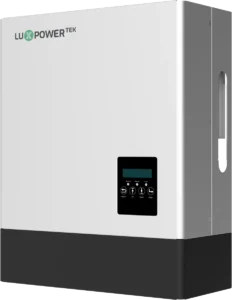Cada vez más personas buscan energía verde. La electricidad de la red eléctrica se está encareciendo. En algunas zonas, incluso es difícil obtener energía confiable. La energía solar, en este caso, puede ayudar a reducir este problema. Es limpia, gratuita y está disponible prácticamente en todas partes. Un inversor solar es el corazón de un sistema de energía solar. En este caso, es crucial analizar los diferentes tipos de inversores solares.
El uso de la luz solar para producir electricidad se está popularizando. La gente busca soluciones solares para sus hogares y espacios comerciales. Quizás usted sea uno de ellos.
Los paneles solares captan la luz solar y la convierten en energía. Pero los paneles solares por sí solos no son suficientes. Para aprovechar esta energía, se necesita un inversor solar que la convierta en energía utilizable. Un inversor solar transforma la corriente continua (CC) de los paneles en corriente alterna (CA). La CA es la corriente que necesitamos para que funcionen la mayoría de los electrodomésticos.
Este artículo trata sobre los inversores solares y sus tipos. También aprenderá sobre los inversores híbridos y su flexibilidad.
Presentamos los inversores solares

Un inversor solar es el dispositivo principal de un sistema de energía solar. Convierte principalmente la corriente continua de los paneles solares en corriente alterna. Esta es su función principal.
Manteniendo las funciones principales, la mayoría de los inversores modernos ofrecen más funciones para facilitar nuestro estilo de vida. Por ejemplo, el suministro de energía ininterrumpido, la medición neta y el VPP son algunas de las características más populares. Su panel solar podría estar produciendo más energía. Los paneles solares modernos pueden suministrar esta energía adicional a la red. De esta manera, usted gana créditos. Además, la integración perfecta entre la red y la batería también garantiza un suministro de energía constante.
Las configuraciones de energía solar e inversor suelen ofrecer diversas opciones. En la mayoría de las aplicaciones, es común una potencia de 300 W a 50 kW o más. Para su hogar, un sistema de energía solar de 3 kW a 5 kW podría ser suficiente.
Un sistema de energía solar comienza captando la luz solar en los paneles solares. Estos paneles la convierten en corriente continua (CC). Cada panel de la instalación puede producir diferentes rangos de CC. Toda esta CC se fusiona en un canal y se envía al inversor fotovoltaico. El inversor fotovoltaico o inversor solar se encarga del resto.
Los inversores solares son cada vez más populares. Se utilizan principalmente en viviendas. Permiten obtener electricidad limpia de los paneles solares instalados en el tejado. Además, también se utilizan ampliamente en edificios comerciales. Permiten alimentar oficinas, fábricas y centros comerciales.
Además, en muchos sistemas aislados, los inversores solares son adecuados. En estos sistemas, solo se puede depender de recursos naturales, y la energía solar es uno de ellos. También se pueden considerar parques solares, grandes proyectos de servicios públicos y más.
Tipos de inversores de conexión a red
Hoy en día existen varios tipos de inversores solares. Cada uno tiene sus propios propósitos y aplicaciones. En este caso, seleccionar el tipo adecuado es complicado. Es importante comprender las diferencias entre cada uno. Posteriormente, según el tamaño de su sistema, su presupuesto y sus necesidades energéticas, podrá seleccionar la opción adecuada para su proyecto. En general, existen tres tipos principales de inversores solares.
Inversores de cadena tipo #1
Un inversor de cadena es el tipo más común de inversor solar utilizado en sistemas solares residenciales. Cuenta con un inversor central que convierte la CC de todos los paneles solares en CA. Los paneles están conectados en serie. De ahí su nombre: "inversor de cadena". En este tipo de configuración, toda la energía fluye a través de este único inversor.
Los inversores de cadena suelen funcionar mejor cuando se colocan todos los paneles en la misma dirección. Si un panel queda sombreado o dañado, puede reducir la potencia de todo el sistema. Estos inversores son muy sencillos, fiables y rentables. Por ello, se suelen elegir para instalaciones regulares.
Pros
- La solución más rentable
- Un método sencillo y ampliamente utilizado
- Funciona bien cuando no todos los paneles están sombreados.
Contras
- El sombreado o daño en un panel reduce el rendimiento general.
- No se puede monitorear cada panel individualmente
- No es ideal si los paneles están orientados en direcciones diferentes
- Para ampliar el sistema puede ser necesario un segundo inversor
Microinversores tipo #2
Los microinversores suelen ser pequeños y se instalan debajo de cada panel solar. Cada panel convierte su corriente continua (CC) en corriente alterna (CA) directamente en el panel. De esta manera, cada panel puede funcionar de forma independiente. El sombreado o los daños en un panel no afectarán el rendimiento general del sistema.
Los microinversores también permiten monitorear la producción de cada panel. Se puede detectar si un panel tiene un rendimiento bajo y solucionarlo rápidamente. De esta manera, todo el sistema funciona eficientemente.
Aunque estos inversores son más caros que uno convencional, pueden producir más energía con el tiempo. Los microinversores son ideales para techos con sombreado o paneles orientados en diferentes direcciones. Añadir más paneles en el futuro es más fácil. En general, el sistema se vuelve más flexible ante las crecientes necesidades energéticas.
Pros
- El sombreado afecta solo a un panel
- Monitoreo de paneles individuales
- Fácil ampliación del sistema
- Trabajos en techos con paneles en diferentes direcciones.
Contras
- Costo inicial más alto
- No es necesario si los paneles están orientados en la misma dirección y no están sombreados.
Optimizadores de potencia tipo #3
Los optimizadores de potencia suelen combinar las ventajas de los inversores de cadena y los microinversores. En lugar de instalar microinversores, se instalan optimizadores de potencia debajo de cada panel.
Cada optimizador de potencia, ubicado en cada panel, monitorea el voltaje y la corriente del panel. Luego, ajusta la salida para que el panel produzca la máxima potencia posible, incluso si otros paneles están sombreados o sucios. De esta manera, todo el sistema puede optimizar la salida antes de enviar corriente continua (CC) a un inversor central.
Este sistema reduce el impacto del sombreado o la desadaptación de los paneles. Es más eficiente que un inversor de cadena. Además, es más económico que una configuración de microinversor. Los optimizadores de potencia también permiten supervisar el rendimiento de cada panel.
Esta configuración suele ser adecuada para techos con sombreado parcial o paneles orientados en múltiples direcciones. Si bien el costo inicial es elevado, es menor que el de instalar microinversores. Los optimizadores garantizan el máximo rendimiento de cada panel.
Pros
- Mayor eficiencia que los inversores de cadena
- Monitoreo de paneles individuales
- Menos costoso que los microinversores
- Bueno para techos parcialmente sombreados o complejos.
Contras
- Coste inicial más elevado que los inversores de cadena
- No es necesario para paneles sin sombra y con orientación uniforme
Presentamos los inversores híbridos

Un inversor híbrido es un tipo de inversor solar que gestiona la energía de paneles solares, baterías y la red eléctrica. Es mucho más flexible y eficiente. Puede almacenar el exceso de energía solar en baterías para su uso posterior. Garantiza el suministro eléctrico incluso durante cortes de luz o por la noche. Los inversores híbridos son ideales para usar donde se necesita electricidad ininterrumpida.
En Inversores híbridos LXP Están disponibles en diferentes tamaños. Los modelos monofásicos y de fase partida admiten hasta 12 kW. Por otro lado, los modelos trifásicos están disponibles hasta 30 kW. Estos inversores son adecuados para todo tipo de instalaciones.
Los inversores híbridos son compatibles con los tres tipos de inversores solares mencionados anteriormente. Se pueden usar con inversores de cadena, microinversores y optimizadores de potencia. Esta flexibilidad suele hacer que los inversores híbridos sean compatibles con prácticamente cualquier instalación solar.
La mayoría de los inversores híbridos modernos incorporan sistemas avanzados de monitorización e integración VPP. Permite monitorizar la producción de energía, el nivel de batería y el consumo en tiempo real. Los inversores híbridos LXP ofrecen control remoto mediante aplicaciones móviles. Estas funciones facilitan la optimización del consumo energético y la reducción de la factura eléctrica.
Los inversores híbridos podrían ser una opción inteligente para su hogar y negocio. Si busca eficiencia, fiabilidad y una instalación solar preparada para el futuro, considere los inversores híbridos LXP.
Cosas que debe saber antes de adquirir un inversor solar
No todos los inversores funcionan igual. Debe elegir el inversor solar adecuado para obtener la máxima eficiencia. Algunos factores pueden afectar la cantidad de energía que obtiene de sus paneles solares. Es fundamental comprenderlos, ya que esto le ayudará a elegir un inversor eficiente.
Recorte o scalping
El recorte suele ocurrir cuando el inversor solar no puede gestionar la salida máxima de los paneles. El inversor limita la energía y se pierde algo de electricidad. Por otro lado, el scalping ocurre en pequeñas cantidades. Un buen inversor debe minimizar el recorte o el scalping para maximizar la energía que producen los paneles.
Eficiencia del inversor
La eficiencia del inversor es el porcentaje de electricidad de CC convertida a CA sin pérdidas. Una mayor eficiencia se traduce en mayor potencia utilizable. La mayoría de los inversores modernos, como los LXP, alcanzan eficiencias de hasta 99%.
Potencia máxima, MPP y punto de potencia pico
El punto de máxima potencia (MPP) es el punto donde un panel solar produce su máxima potencia. Cada panel tiene un MPP diferente. Este puede depender de diversos factores, como la luz solar, la temperatura y la carga. Un MPPT (seguidor del punto de máxima potencia) en el inversor detecta constantemente este punto.
El MPPT suele ajustar el voltaje y la corriente para garantizar que el panel siempre funcione a su máximo rendimiento. De esta manera, puede aprovechar al máximo la energía de su sistema solar.
Sin MPPT, sus paneles podrían producir menos energía que su capacidad máxima. Los inversores modernos rastrean el MPP varias veces por segundo para maximizar la eficiencia.
¿Listo para encenderse?
Al elegir un inversor solar, debe prestar atención a tres especificaciones clave. Revise las garantías para garantizar una protección a largo plazo. En segundo lugar, observe el rango de temperatura de funcionamiento. Esta debe ser compatible con su clima. Intente verificar el sistema de disipación de calor del inversor. En tercer lugar, considere la eficiencia general del producto.
Si tiene alguna pregunta o está interesado en elegir inversores LXP, no dude en contactarnos. Contacto.

